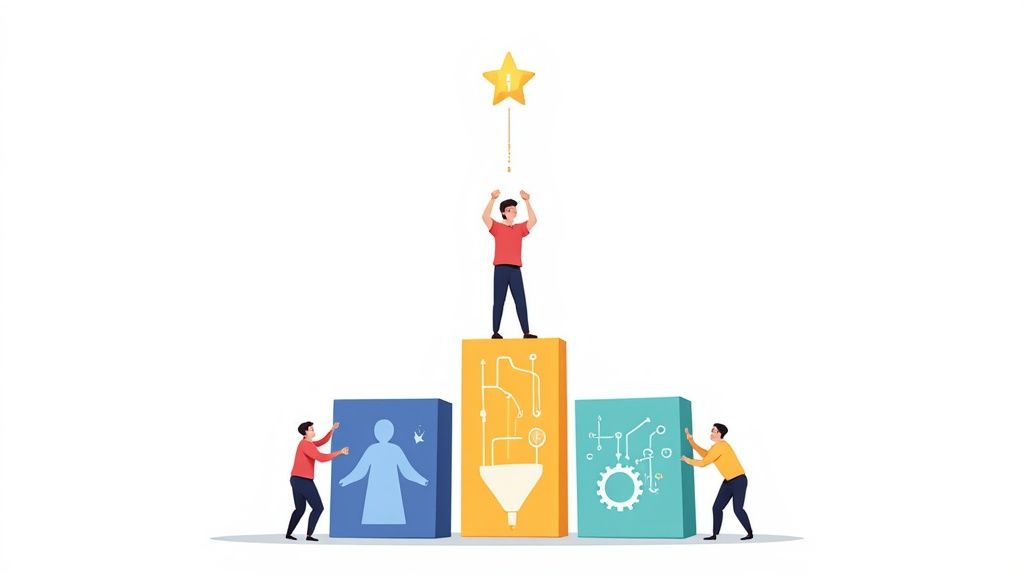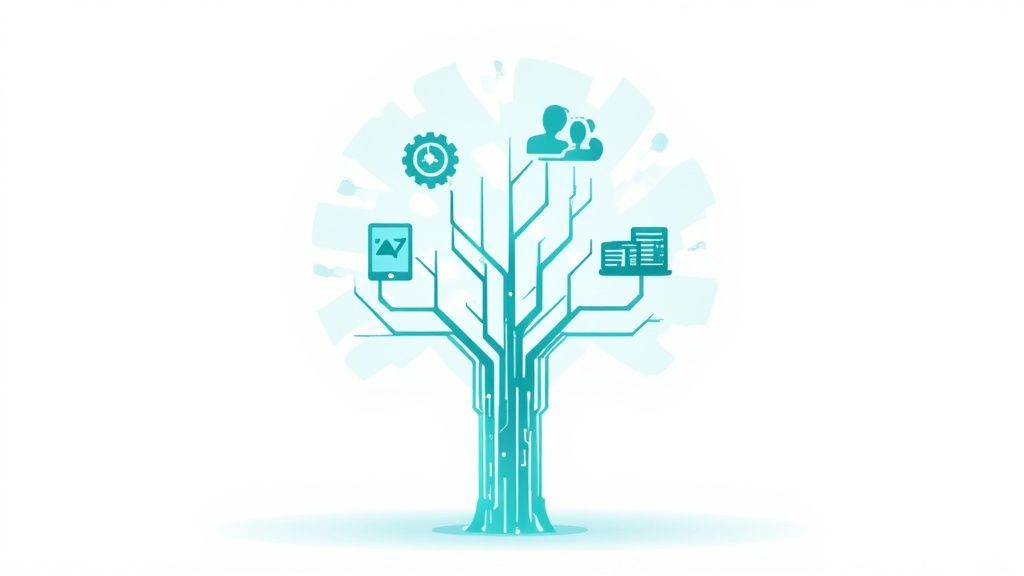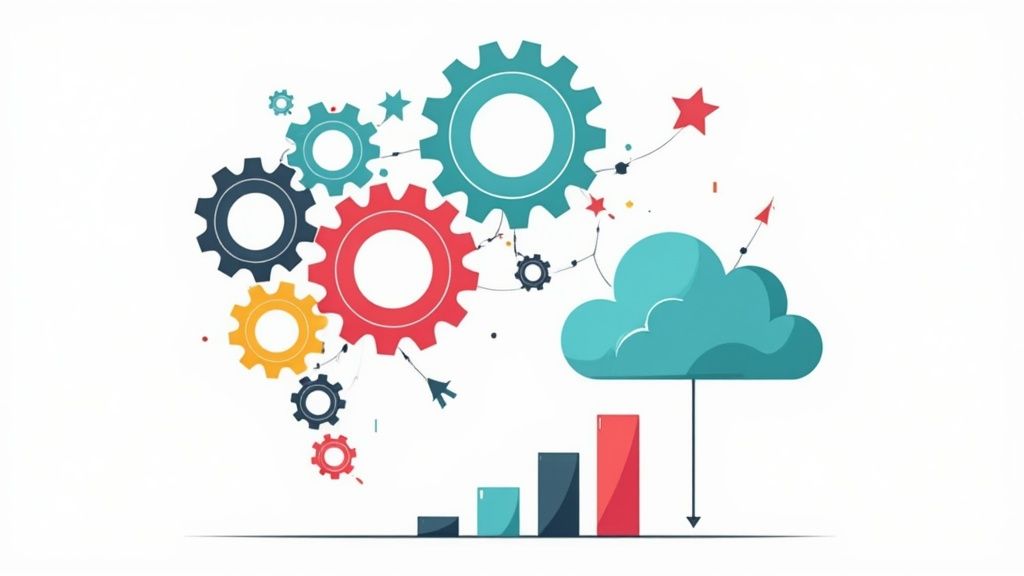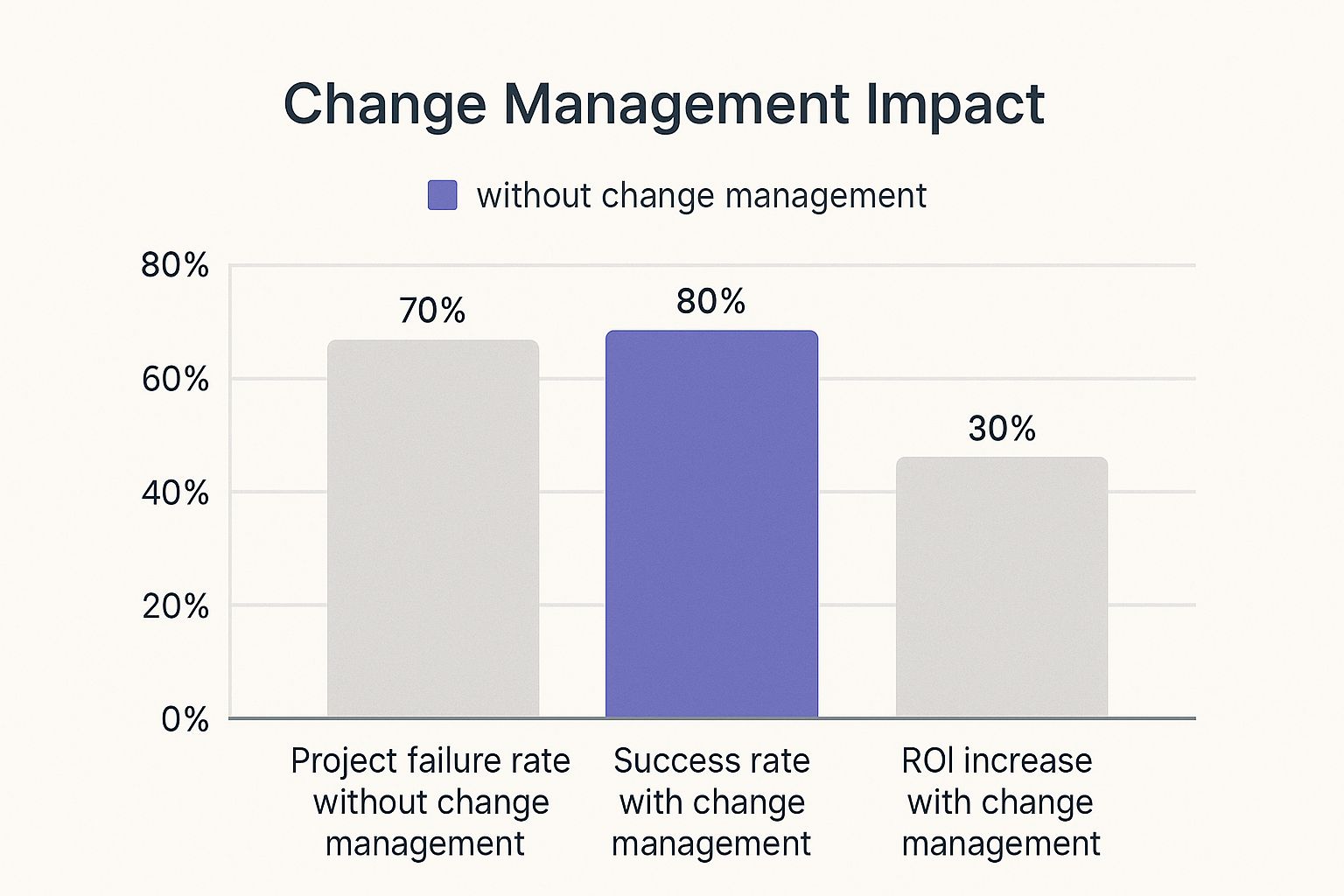Let's be candid. The phrase "operational excellence framework" is often used as just another piece of corporate jargon. It can feel intimidating and overly complex. At its heart, however, the idea is quite simple.
Think of it less as a rigid manual and more as your organisation's internal compass. It guides your people, processes, and technology toward a single, powerful goal: continuous improvement. It is the system that fuels sustainable growth and, crucially, gives your team their time back.
What An Operational Excellence Framework Really Is

So, what are we really talking about? An operational excellence framework creates a culture where every single person feels empowered to spot and eliminate waste, smooth out friction, and ultimately deliver more value to your customers.
It is not about chasing an abstract idea of perfection with overwhelming spreadsheets or top-down commands. A framework that actually works starts with your people. It gives them the clarity, the tools, and most importantly, the permission to make smarter, more confident decisions every day.
When everyone in the organisation understands the journey of value from your business to the customer, they become incredibly adept at spotting when that flow gets blocked or slowed down. This shared insight is the bedrock of a resilient and truly capable organisation. It fundamentally shifts the mindset from blaming individuals for process snags to collectively improving the process itself.
The real-world impact
This is not just theory. Across the UK, organisations in both the public and private sectors are using these frameworks to completely reshape how they operate. From Health and Local Government to Transport, these principles are being used to benchmark performance and build clear, actionable plans for improvement. The results are tangible: better services, higher satisfaction, and a much smarter use of precious resources.
A well-implemented framework directly tackles the blockers that keep leaders up at night. It helps your organisation:
- Reclaim Time. By systematically identifying and stripping out inefficient steps, your team spends less energy on low-value tasks and can focus on the work that truly drives the business forward.
- Sharpen Decisions. With clear data and aligned goals, decisions are made faster and more consistently. They become grounded in reality, not guesswork.
- Build Lasting Capability. The skills and mindset for continuous improvement become embedded within your teams. This creates a kind of digital sovereignty that does not vanish the moment a consultant walks out the door.
We believe true transformation is about creating a system where improvement is continuous and owned by everyone. It is about building an organisation that is fundamentally more open, capable, and operationally sustainable from the ground up.
To get the full picture of what this can achieve, it helps to explore the wider strategies for improving operational efficiency. At the end of the day, the goal is to create an environment where doing the right thing becomes the easiest thing for everyone to do.
The Three Pillars Of A Sustainable Framework
A powerful operational excellence framework is not a complex web of rules. It is actually built on three core pillars that have to be perfectly aligned: people, process, and technology. When these three work in harmony, they create a foundation for genuine, sustainable change. But if any one of them is weak or out of sync, the whole structure is at risk of collapse.
At Yopla, we have seen time and time again that real transformation always starts with people. It is a principle we never compromise on. From there, we look at the processes they use. Only then do we bring technology into the conversation. This people-first order is intentional and, frankly, it is critical for success.
Pillar 1: People – the foundation of change
Your team is, without a doubt, the most critical part of any operational excellence framework. You can have the most brilliantly designed processes and the flashiest tech. Without your team’s buy-in, engagement, and empowerment, none of it will deliver lasting value. The goal is to build a culture where improvement is a collective responsibility, not just another top-down mandate.
This all starts with fostering psychological safety. Every single team member needs to feel confident enough to voice concerns, point out problems, and suggest solutions without any fear of blame. It also demands a real commitment to continuous learning, making sure everyone understands their role and, crucially, how their work contributes to the bigger picture.
When people are genuinely engaged, they stop being passive cogs in a machine and become active owners of the process. You can learn more about creating this kind of environment in our guide on how to build high-performing teams. This cultural shift is the single most important investment you can make.
Pillar 2: Process – the blueprint for value
Once your people are empowered and on board, the next step is to examine the processes they use every single day. A process is really just the journey that value takes through your organisation to get to the customer. The whole point here is to make that journey as smooth, efficient, and direct as possible.
This pillar involves taking a brutally honest look at your current state. We help clients map out their existing workflows to pinpoint the real bottlenecks, redundancies, and points of friction. These are the things that drain time, frustrate your teams, and slow down your service.
Redesigning a process is not about enforcing rigid, bureaucratic steps. It is about creating clarity and removing obstacles so that your team's talent can flow freely towards creating value, not fighting the system.
The goal is to design workflows that are both efficient and adaptable. A great process gives people clear guardrails but also leaves room for innovation and human judgement. This prevents the kind of stifling rigidity that absolutely kills morale and momentum.
Pillar 3: Technology – the enabler of action
Technology is the final pillar, and we place it here for a very deliberate reason. Tech should serve your people and your processes, never the other way around. Far too many organisations make the classic mistake of buying a new, expensive platform, hoping it will magically fix their problems, only to find it just adds another layer of complexity.
The right way to approach it is to choose and implement tools that genuinely amplify your team's efforts and support your newly streamlined processes. This could mean automating repetitive, low-value tasks to free up your people for more strategic work. Or it might involve a shared data platform that gives everyone access to the same insights, sharpening collective decision-making.
This simple hierarchy shows how your vision and mission should directly inform your strategic goals and the metrics you use to track them.
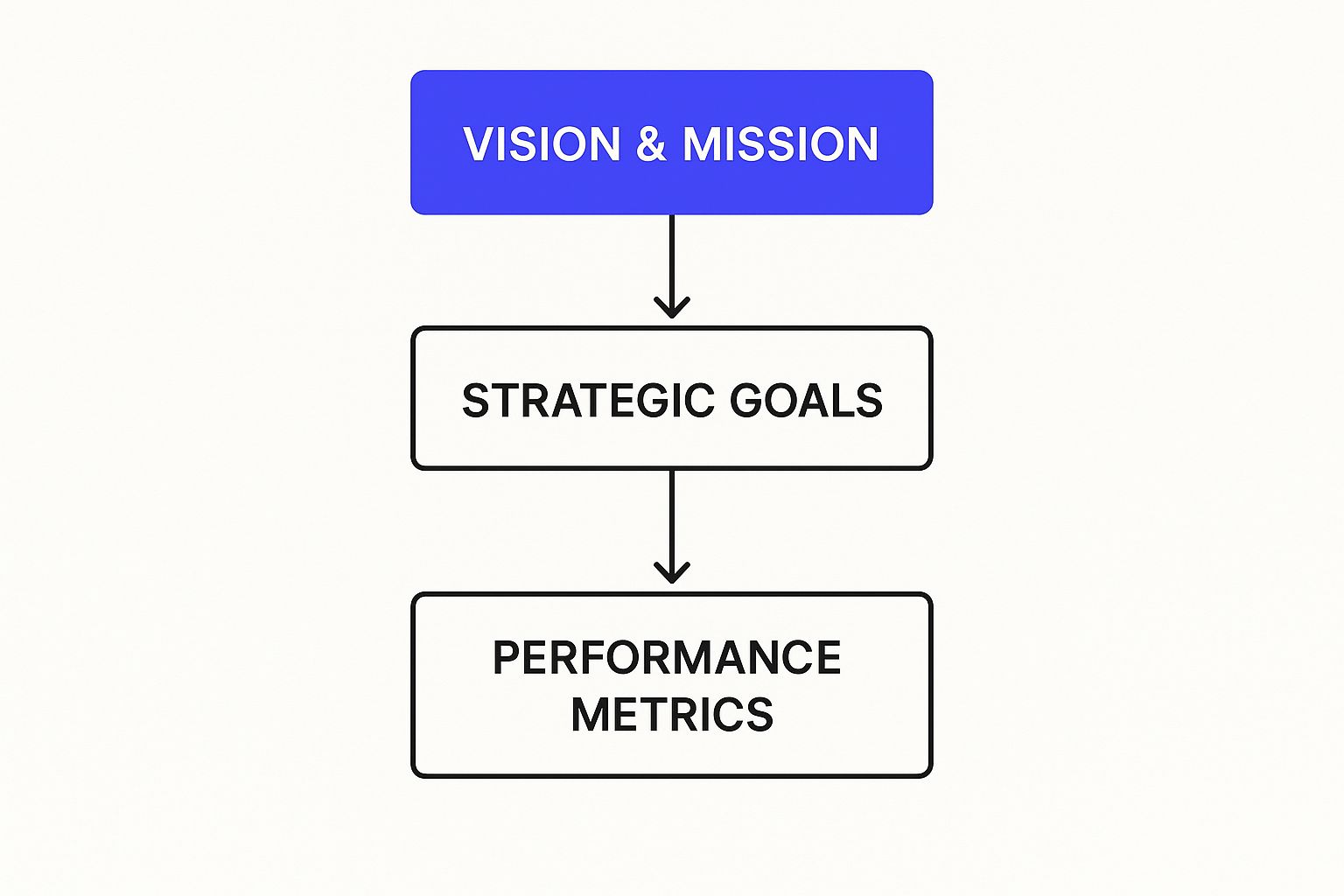
As the diagram shows, technology and processes are simply tools to achieve your strategic goals, which are themselves expressions of your company's core mission. By getting these three pillars perfectly aligned, you build a system where every part of the organisation is pulling in the same direction, creating a powerful engine for continuous improvement.
Choosing Your Continuous Improvement Methodology
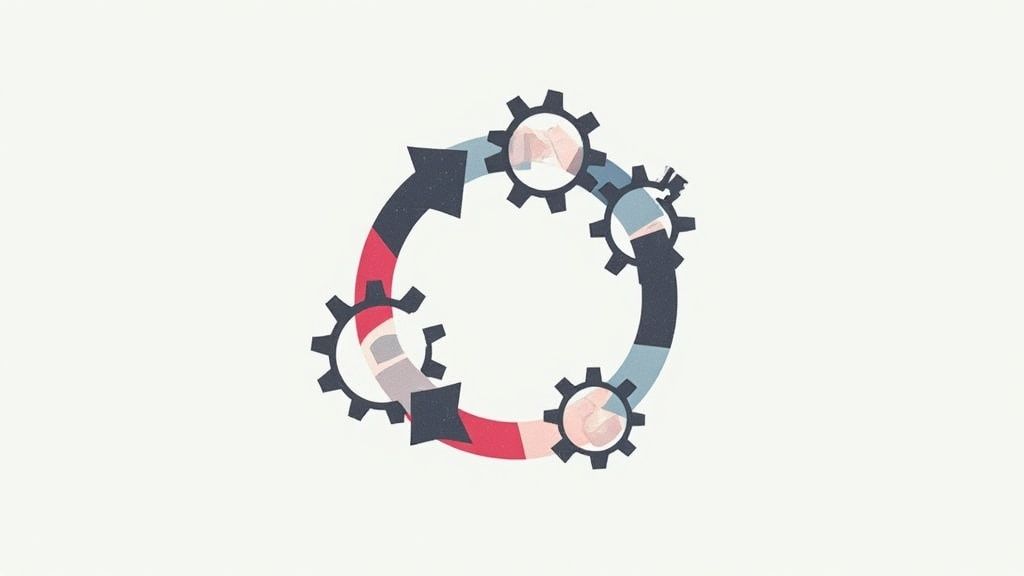
If your operational excellence framework is the house you are building, then the improvement methodologies are the tools you actually use to put it all together. A solid framework gives you the blueprint and direction, but it is the right methodology that gives you the practical means to get things done.
Choosing the right one is not about finding the "best" one on paper. It is about finding what fits your organisation’s culture and the real-world problems you are trying to solve. You could have the most advanced toolkit in the world, but if your team does not know how to use it, or worse, does not want to, you are just going to create frustration.
Instead of trying to force a square peg into a round hole, it is much smarter to understand the philosophies behind the big names. That way, you can pick the one that will genuinely click with your people and deliver real value, whether you are fine-tuning a digital workflow or a factory floor.
Understanding Lean: the relentless pursuit of less
At its very core, Lean is about one thing: the ruthless elimination of waste. Think of it like a professional declutterer for your entire business. Just like you would get rid of junk in a room to make it more liveable and functional, Lean aims to strip out any activity that does not add a single drop of value for your customer.
And "waste" here is not just about leftover materials. It is the wasted time from pointless process steps, the wasted potential of your team’s untapped skills, and the wasted effort of making something nobody really wants. Lean constantly forces you to ask, "Does this step actually create value for the customer?" If the answer is no, the follow-up is always, "So how do we get rid of it?"
This is why Lean is so powerful. It cuts through the noise and complexity. It forces you to take a hard, honest look at what truly matters, which frees up your team's precious time and energy to focus on the work that moves the needle. To dive even deeper into this, you can learn more about what process reengineering is and see how it works hand-in-glove with Lean thinking.
Six Sigma: the data-driven drive for perfection
While Lean is all about speed and flow, Six Sigma is obsessed with quality and consistency. Its goal is to slash errors and defects down to a near-perfect level. Imagine a baker who needs every single loaf of bread to be identical in weight, texture, and taste. Six Sigma gives them the statistical tools to achieve that.
This methodology is unapologetically data-driven. It relies on a structured, five-phase approach called DMAIC (Define, Measure, Analyse, Improve, Control) to pinpoint the root causes of any variation in a process. There is no room for guesswork or gut feelings here. It is all about gathering hard evidence to understand why things go wrong and then implementing robust changes to stop them from happening again.
Six Sigma really shines in organisations where consistency is everything. It offers a rigorous, mathematical way to make your processes predictable and reliable, which is absolutely vital for building trust and keeping customers happy.
Kaizen: the power of small, everyday improvements
Kaizen is a Japanese term for "continuous improvement," and its philosophy is beautifully simple. It is built on the belief that tiny, incremental changes, made consistently by everyone, every day, lead to massive, game-changing results over time. It is the complete opposite of a big, disruptive overhaul.
Think of it as compounding interest for your business processes. Kaizen nurtures a culture where every single employee, from the CEO to the front-line staff, feels empowered to spot small opportunities for improvement in their daily work. This could be as simple as reorganising a shared drive for quicker access or tweaking an email template for better clarity.
This approach is brilliant for building momentum and sidestepping the natural resistance people have to change, because the steps are so small and manageable. It empowers people at every level, driving home the idea that everyone has a stake in making the organisation better. To really nail this, businesses often use tools to track key metrics, like industrial energy consumption calculators, which help quantify waste and support Kaizen’s focus on those small, incremental gains.
Comparing core improvement methodologies
With these three distinct philosophies, how do you know where to start? Each has its own strengths and is designed to tackle different types of problems.
This table breaks down the core focus of each methodology to help you see which one might be the best fit for your current challenges.
Ultimately, the best approach is often a blend. You might use Lean principles to identify waste, Six Sigma tools to solve a complex quality issue, and Kaizen to ensure everyone is continuously looking for ways to improve. The key is to see them not as rigid, competing systems, but as a flexible toolkit for operational excellence.
How The Public Sector Creates Value With Operational Excellence
When you hear the term ‘operational excellence framework’, your mind probably jumps straight to the private sector, companies trimming costs and chasing bigger profit margins. It is an easy assumption to make. But the core ideas behind it, wiping out waste, focusing on what delivers real value, and empowering people, are completely universal.
In fact, these principles can deliver incredible public value when applied with the same discipline in government and public services. The goal simply shifts. Instead of profit, the prize is better, more accessible, and more efficient public services for everyone.
This is not just a theory. The UK has a powerful, real-world example of this in action. By putting citizens at the very centre of every single decision, government bodies can transform how they deliver services, rebuild public trust, and make far smarter use of taxpayer money. The concept is the same. Start with what people actually need, untangle the processes that serve them, and use technology to make it all run smoothly.
A case study in public value: the UK’s GDS
One of the most compelling stories of operational excellence in the public sector comes from the UK Government Digital Service (GDS). Handed a truly monumental challenge, GDS set out to completely reshape the citizen experience, armed with principles pulled straight from Lean thinking and a culture of non-stop improvement.
Their approach was refreshingly clear and fiercely people-first. Instead of getting bogged down in complex technology discussions, they began with a simple question: What does the user need? This relentless user-centric focus was the key that unlocked everything, forcing them to slice through decades of bureaucratic red tape and rebuild services from the ground up.
A standout success is the creation of the Gov.uk platform. Before it existed, trying to find government information was a nightmare. Citizens had to navigate a confusing maze of hundreds of different, inconsistent government websites.
GDS applied an operational excellence framework to this mess by standardising digital processes and obsessively optimising how information was organised and presented. By consolidating over 330 different government services into a single, intuitive hub, GDS massively improved efficiency. This one move led to an estimated 20% reduction in public enquiries and earned citizen satisfaction rates that consistently soared past 80%. You can learn more about how they delivered an effective operational excellence model in the public sector.
Key lessons from the GDS success story
The GDS journey offers a powerful blueprint for any organisation, whether public or private, that is serious about achieving a breakthrough. Their success was not down to luck. It was built on a clear set of principles that any leader can learn from and apply.
Three lessons, in particular, stand out:
- Unyielding Leadership Commitment. The transformation was driven from the very top. This was not just quiet approval. It was active, visible leadership that cleared roadblocks and constantly reinforced the importance of the mission.
- A Relentless Focus on the User. Every single decision was measured against the needs of the citizen. This provided a powerful filter, helping the team cut through internal politics and focus only on what truly mattered.
- Data-Driven, Iterative Improvement. GDS operated like a modern tech company, not a slow-moving government department. They launched minimum viable products, gathered real-world data on what worked, and improved in small, rapid cycles. They were not afraid to fail, learn, and adapt on the fly.
This case study is proof that operational excellence is far more than just another corporate buzzword. It is a practical, powerful way to create real-world value, whether that value is measured in shareholder returns or in the quality of public services delivered to citizens.
By embedding these principles deep into their DNA, GDS built more than just a website. They built a more capable and responsive way of working that continues to leave a lasting legacy of better service delivery and a smarter, more efficient government. This is the true promise of a well-executed operational excellence framework.
Navigating The Common Roadblocks To Success

Embarking on an operational excellence journey is exciting. The destination, a smarter, more capable, and efficient organisation, is always worth the effort. But like any major initiative, the path is rarely a straight line. It is often dotted with predictable roadblocks that can trip up even the most enthusiastic teams.
Ignoring these hurdles is the quickest way to watch a promising programme lose momentum and fade away. At Yopla, we are firm believers in facing these challenges head-on. By anticipating them, you can build strategies to navigate around them, turning potential points of failure into moments that actually strengthen your resolve.
The ultimate success of an operational excellence framework rarely comes down to the methodology you choose. It almost always depends on how well you handle the human side of change. Let’s break down the most common challenges leaders face.
The challenge of securing genuine leadership buy-in
It is one thing for leaders to nod along in a meeting. It is another for them to actively champion the cause. While most executives will verbally support a push for operational excellence (who doesn’t want a more efficient business?), the gap between passive agreement and active, visible support is often the first and biggest hurdle.
Without true sponsorship from the top, initiatives are starved of oxygen. They lack the resources, authority, and strategic priority to survive when things get tough. A global study highlighted this perfectly, finding that 23.2% of organisations name a lack of leadership buy-in as the main barrier to success. To learn more about the research, you can explore the full findings here.
Real leadership buy-in is not a one-time signature on a project charter. It is consistent, public support. It is asking the right questions in meetings, clearing roadblocks for the team, and celebrating the small wins along the way. It is showing, not just telling, everyone that this matters.
To earn that level of commitment, you have to connect the framework directly to the strategic goals that keep your leaders up at night. Do not talk about "improving processes." Instead, talk about "freeing up 15% of our senior team's time for innovation" or "cutting customer support tickets by 25%." Make the value so tangible it is impossible to ignore.
Overcoming cultural resistance and maintaining momentum
The next major roadblock is your company culture. People are naturally cautious about change, especially when it feels like just another top-down initiative that adds to their workload. If your team views "operational excellence" as a thinly veiled critique of their work or a threat to their job security, they will resist, either openly or, more likely, behind the scenes.
The trick is to frame it not as a fault-finding mission, but as a shared effort to make everyone's work life better. Focus on eliminating the frustrating, repetitive, low-value tasks that everyone already hates. When people see the goal is to remove friction and make their jobs easier, they quickly turn from adversaries into allies. We cover this in more detail in our guide on overcoming resistance to change for digital transformation success.
This is directly linked to the third challenge: keeping the momentum going. The same study found that a staggering 35.6% of companies struggle to execute their projects sustainably. The initial buzz can fade fast if tangible results do not appear or if no one feels accountable.
To fight this project fatigue, you need two key ingredients:
- Early, Visible Wins. Kick off with a small, high-impact pilot project. Solving a well-known, nagging problem within the first 90 days builds incredible credibility and momentum.
- Clear Accountability. Do not let this be "management's project." Appoint and empower internal coaches or champions within departments. When people feel a sense of ownership over their part of the process, the programme begins to sustain itself.
Successfully navigating these roadblocks is all about a people-first approach. By securing genuine leadership, building a positive case for change, and delivering value quickly, you are not just implementing a framework. You are building a culture where it can truly thrive.
Right, so you have the theory down, but theory alone does not change a thing. It is action that counts. The idea of launching a full-blown operational excellence framework can feel massive, like you are staring up at a mountain. But you do not start the climb with a giant leap to the summit. It all begins with a single, well-placed step.
The trick is to cut through the noise and focus on practical moves that build real momentum. Forget trying to boil the ocean. In our experience, the most successful programmes are the ones that start small, prove their value fast, and then use that early win to get everyone else on board. You are aiming to create a ripple effect, not a tidal wave.
Identify your pilot project
The best way to kick things off is by picking one, high-impact process to fix first. This ‘pilot project’ is your testing ground. It is a chance to try out your approach, learn quickly, and deliver some solid results in a short amount of time. This is not just about solving a problem. It is about building belief in what is possible.
To pick the right pilot, look for a process that is:
- Highly Visible. Choose something that everyone in the business knows is a source of friction.
- Clearly Bounded. The process needs a clear start and finish. This makes it much easier to measure how much you have improved things.
- Painful but Solvable. It should be a real headache for people, but not so hopelessly complicated that you cannot sort it out within a 90-day window.
A classic example? The internal approval workflow for expenses or hiring a new team member. It is almost always slow, tangled in red tape, and universally disliked. That makes it the perfect candidate for a quick, visible win that frees up time and builds a ton of goodwill.
Assess your readiness for change
Before you dive in, you need to take an honest look in the mirror. A framework needs more than a great plan to succeed. It needs the right environment to grow. A quick readiness check can shine a light on potential roadblocks before they have a chance to trip you up.
We believe that starting any transformation begins with asking candid questions. Clarity on where you stand today is the most powerful tool you have for planning where you want to go tomorrow.
Use this simple checklist to get a sense of where you are. Be brutally honest. The aim here is to spot your strengths and figure out which areas need a bit of work before you get started.
Leadership Readiness:
- Is there at least one senior leader who is actively and visibly championing this?.
- Have we clearly linked this project to a key strategic goal for the business?.
- Are our leaders ready to commit actual resources (people’s time, not just money) to the pilot?.
Team Capability:
- Have we put together a small, cross-functional team to run the pilot?.
- Does this team feel genuinely safe enough to challenge how things are currently done?.
- Do they have the time and the authority to actually make changes to the process?.
Data and Process Clarity:
- Can we easily map out the current steps of our chosen pilot process?.
- Do we have access to the basic data we need to measure its performance right now (like how long it takes, or the error rate)?.
- Is there a shared understanding across the team of why this process is broken and needs fixing?.
Answering these questions gives you a solid, grounded starting point. It helps you move from the abstract concept of an operational excellence framework to a concrete plan of action, giving you the confidence to take that all-important first step.
Frequently Asked Questions
When you start digging into the idea of an operational excellence framework, it is only natural for a few questions to pop up. We get them all the time from leaders who are ready to stop talking and start building a more capable organisation.
Here are some of the most common ones we hear, with candid answers grounded in what we have seen work in the real world.
How long does it take to see results?
This is the big one, isn't it? While the deep, cultural shifts take time to embed, you absolutely do not have to wait years to see a return on your effort. In fact, you can often see tangible results from your first pilot projects in as little as 90 days.
These early wins are crucial. Think about streamlining a painful internal workflow or shaving days off a new customer onboarding process. Seeing that kind of progress builds the momentum and belief you need for the bigger journey ahead. The aim is always iterative, visible improvement, not some far-off, distant transformation.
Is this only for large manufacturing companies?
Not a chance. That is a common misconception, probably because a lot of these ideas were born on the factory floor. But the core principles, eliminating waste, improving flow, and empowering your people, deliver enormous value no matter what industry you are in.
We have seen these concepts work wonders in:
- Service-based businesses.
- Non-profits and charities.
- Healthcare organisations.
- Digital-first tech companies.
The "factory floor" just looks different. Instead of a production line, you are optimising digital processes, team workflows, and the customer journey.
Do we need to hire a team of specialists?
No, you do not need to go on a hiring spree for a big, dedicated team at the start. Real success begins with two things: a solid commitment from leadership and a small, cross-functional group of your own people to act as ‘change agents’.
These are the motivated folks already in your organisation who live the processes every day and know exactly where the frustrations are. An external partner, like Yopla, can then act as a copilot. We bring the operational excellence framework and expert coaching to build that capability inside your team. This ensures the knowledge and ownership stay with you for good, which is fundamental to our principle of digital sovereignty.
How do we measure the success of our framework?
You will want to measure success with a mix of hard numbers and softer, qualitative improvements. The most important thing is that your key metrics are directly tied to the specific problems you set out to solve.
Success is not just a number on a dashboard. It is the palpable feeling that your teams have more time to focus on high-value work because inefficient, frustrating tasks have been systematically reduced or automated.
Look for tangible shifts in metrics like:
- Reduced cycle times for key processes.
- Lower error rates or fewer customer complaints.
- Improved customer satisfaction and Net Promoter Scores (NPS).
- Higher employee engagement and satisfaction survey results.

